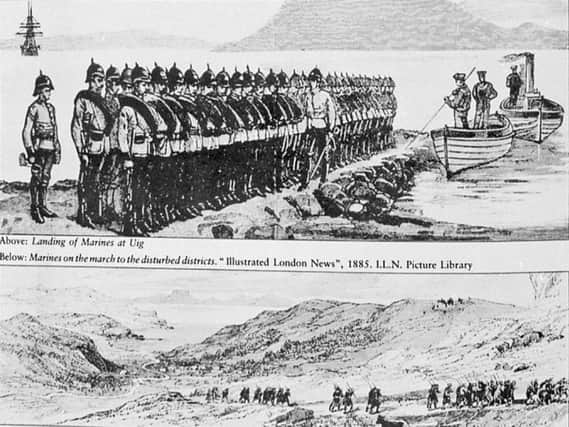When 400 marines were sent to evict crofters from Skye


Around 400 marines were dispatched to Uig in Skye this week in 1884 as the authorities sought to quell rising resistance among crofters against rent increases imposed by their landlord.
The Battle of the Braes had been fought two years ago earlier after Lord MacDonald pushed up the rent of his tenants.
Advertisement
Hide AdAdvertisement
Hide AdPolice were sent and a bloody fight between police and a a group of around 130 men and women unfolded in the townships.
By the time crofters were protesting at Uig, the ante was upped with the military back up called in by Sheriff William Ivory of Inverness, who requested assistance from the government.
Unrest was growing over further increases imposed by Major Fraser of Kilmuir after he bought over part of Lord MacDonald's land.
On 16 November 1884, around 400 marines were stationed on Skye after three vessels - The Assistance along with gunboats HMS Forester and HMS Banterer, ploughed up the Sound of Raasay bound for Rubha Hunish and Uig Bay.
Their arrival was planned to restore order with plans to issue summonses against 500 tenants of Lord MacDonald and Major Fraser of Kilmuir, according to accounts.
But the crofters were prepared well in advance for this arrival of state force with details of the military operation leaked by local telegraph clerks. Meanwhile, innkeepers and hoteliers refused to give lodgings to the police sent to accompany the military, according to historian James Hunter in his book, Skye, The Island.
As word spread of the planned evictions, captain and crew of the the locally-based steamer Lochiel resigned in order to avoid any association with those sent to quell the protest.
The vessel, however, was soon staffed with new personnel and sent to join the flotilla that was brought under the personal command of Sheriff Ivory.
Advertisement
Hide AdAdvertisement
Hide AdHe ordered 250 marines to leave the Assistance and march to Staffin with a briefing to deal rigorously with any opposition encountered on the way, Hunter wrote.
But no unrest was to be found, with the military receiving the most passive of welcomes.
Hunter said: "A Union Jack had been hoisted above once croft house on the slopes above Uig. Outside, another white flag fluttered mockingly in the breeze.
"The Kilmuir tenantry, it was explained to the 16 journalists accompanying the expedition, had no quarrel with the military, only with their landlord."
And hardly any crofter was seen on the 10-mile march.
Hunter added: "As the troops tramped through Brogaig, Stenscholl and Staffin, however, they did not lack company.
"Girls appeared and were soon walking arm in arm with the sweating marines
"The suggestions made in giggling Gaelic to the English soldiers, it was surmised, were not wholly proper.
"This was not quite the civil war that had been expected."
Newspapers reported of this great military presence fuelling only amusement, rather than intimidation, among islanders.
Advertisement
Hide AdAdvertisement
Hide AdAfter the report of the marine’s arrival on Skye appeared in The Times, a telegram was quickly sent by home secretary Sir William Harcourt to Sheriff Ivory to express his surprise that such a march of men was necessary through an "entirely peaceful" district.
Hunter wrote: "There was to be no question, Harcourt reiterated, of using troops for political purposes. Certainly, there was no question of the British army assisting island landlords to evict island tenants.”
The majority of the marines were instructed to leave Skye in December 1884. The remainder were stationed in small detachments scattered throughout the island with the last one withdrawn in June the following year, along with extra police sent to the island.Following the unrest, The Highland Land League was successful in getting Members of Parliament (MPs) elected in 1885 with the Crofters' Holdings Act passed the following year. It addressed many issues, but not the primary concern that not enough land was being made available to crofters.
As a result of reforms which followed, the Kilmuir Estate was eventually bought by the government with a number of sheep farms reverted back into crofts.
Within 25 years, new crofts had been provided for 85 families. Another 268 crofts had been enlarged substantially with the area of cultivated ground rising by a third.
The question, however, of land reform in the Highlands was far from over. Indeed to this day, it evolves and remains.
